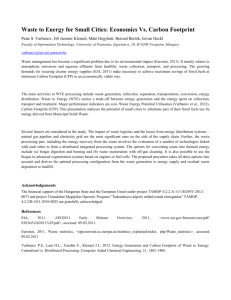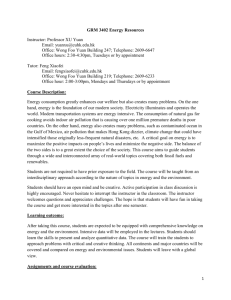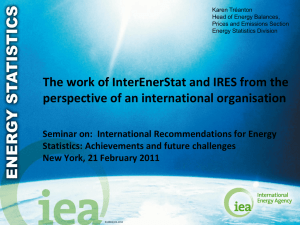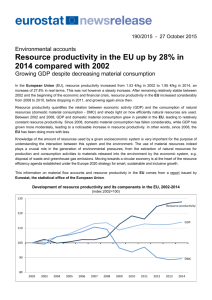Definition of Primary and Secondary Energy
advertisement
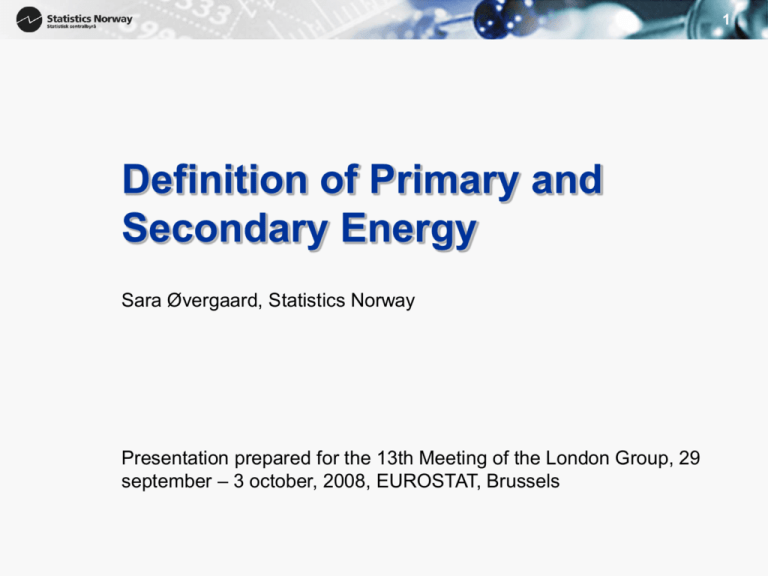
1 Definition of Primary and Secondary Energy Sara Øvergaard, Statistics Norway Presentation prepared for the 13th Meeting of the London Group, 29 september – 3 october, 2008, EUROSTAT, Brussels IRES drafting schedule – Issue 3.4 • International Recommendations on Energy Statistics • Chapter 3. Standard International Energy Classification • ”IRES should contain a clear and internationally agreed definition of primary and secondary energy. This will affect, among other things, the measuring and recording of energy flows in the energy balances.” 2 Current definitions - primary energy • “Primary energy should be used to designate those sources that only involve extraction or capture, with or without separation from contiguous material, cleaning or grading, before the energy embodied in that source can be converted into heat or mechanical work.” UN, Concepts and Methods in Energy Statistics, New York, 1982. • “Energy commodities are either extracted or captured directly from natural resources (and are termed primary) such as crude oil, hard coal, natural gas, or are produced from primary commodities.” OECD/IEA/Eurostat, Energy Statistics Manual, Paris, 2005 • “The extraction or capture of primary fuels or heat and electricity which are retained for sale or use. Quantities reported exclude amounts of inert matter or impurities removed before sale or use and any amounts returned to the natural reserve. However,amounts of the fuel/energy consumed during the production process are included.” InterEnerStat, Mr. Tim Simmons 1st proposal for consultation, august 2008. 3 Creating new definitions • A formal definition consists of three parts – the term to be defined, – the general class to which the term belongs, and – the defining particulars (the distinguishing characteristics) that separate this term from all other members of its class. 4 Primary Energy • Term • • Class • • Primary Energy Sources (UN, 1982) Energy embodied in natural resources (OECD/IEA/Eurostat, 2005) 5 Primary energy – distinguishing characteristics • The definition should – recognize the human factor, – recognize that the important differentiating factor is the process of extraction and capture and – include the purpose of the activity. 6 Proposed definition of primary energy • “Primary energy is energy embodied in sources where human induced extraction or capture, with or without separation from contiguous material, cleaning or grading, must be undertaken before the energy can be traded, used or transformed.” 7 Current definitions - secondary energy • “Secondary energy should be used to designate all sources of energy that results from transformation of primary sources” UN, Concepts and Methods in Energy Statistics, New York, 1982. • • “Secondary energy comes from the transformation of primary or secondary energy.”OECD/IEA/Eurostat, Energy Statistics Manual, Paris, 2005 “The generation or manufacture of energy or fuels from other (usually primary) fuels/energy.” InterEnerStat, Mr. Tim Simmons 1st proposal for consultation, august 2008. 8 Secondary Energy • Term • • Class • • • Secondary Energy Sources (UN, 1982) Energy that comes from… (OECD/IEA/EUROSTAT, 2005) 9 Secondary energy – distinguishing characteristics • The definition should • recognize the human factor, • recognize that the important differentiating factor is the activity of transformation 10 Proposed definition of secondary energy • “Secondary energy is energy embodied in commodities that comes from human induced energy transformation” 11 Electricity - primary or secondary? • The UNSD and the OECD/IEA/Eurostat manual classification of electricity as both primary and secondary is not consistent with its definitions of primary and secondary energy. • A major difference between he Eurostat and IEA Energy Balance format lies in the presentation of primary and secondary energy production – Eurostat do not include electrical energy in the primary production row, but the transformation row. • In the OECD/IEA/Eurostat manual is it argued that energy obtained from devices driven mechanically by air or water only give electricity as output – Not possible to measure the energy actually taken from the source, therefor it is labelled primary 12 Questions for discussion • 1. In the definition of primary energy, what should be the class? – Sources – Natural resources – Natural resources and waste • 2. In the definition of secondary energy, what should be the class? – Sources – Commodities • 3. Is there a statistical need to classify electricity as primary and secondary energy? – If yes, should this be incorporated into a new definition, or – could other terms be used to avoid confusion and double counting? 13 Thank you! • London Group members are welcome to register and participate in the discussions on the Oslo Group website, www.og.ssb.no 14


